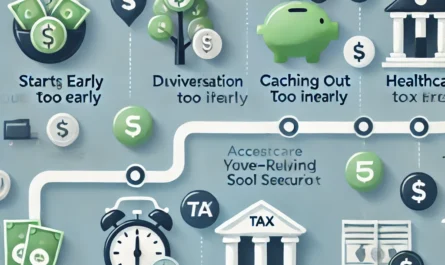Retirement is an exciting phase in life, but without a robust financial plan, it can also be daunting. The days of solely relying on pension plans and Social Security benefits are fading fast, replaced by the need for more proactive financial strategies. This is where passive income comes into play. It’s a key component that can ensure financial independence and long-term stability in your golden years.
Understanding Passive Income
Passive income is often misunderstood, so let’s start with a simple definition. Unlike active income, which requires consistent effort—like working a 9-to-5 job—passive income is earned with minimal ongoing involvement. Think of it as money flowing into your account even while you sleep. Examples include rental income, dividends from stocks, royalties from intellectual property, and interest from bonds.
Passive income is not only crucial for supporting your lifestyle during retirement, but it also offers the freedom to enjoy your retirement without constantly worrying about depleting your savings. By creating multiple streams of passive income, you can mitigate the risk of outliving your retirement funds.
Benefits of Passive Income in Retirement
One of the most appealing aspects of passive income is the security it offers in retirement. Traditional retirement plans like pensions or Social Security may not be sufficient to cover all your expenses. Passive income helps bridge that gap, giving you peace of mind.
Furthermore, passive income can protect against inflation. As the cost of living rises, having an additional stream of income can keep your financial plan on track. You may also find that passive income sources like rental properties or dividend stocks grow over time, providing an increasing cash flow to match inflation.
The biggest advantage, however, is freedom. Without the pressure of returning to work, retirees can focus on enjoying their hobbies, traveling, or spending time with family—knowing they have a reliable source of income to sustain them.
Types of Passive Income Sources
When planning for retirement, it’s essential to consider the wide range of passive income sources available. Different income streams come with varying levels of risk, effort, and return. Here’s a breakdown of some of the most effective options:
- Dividend Stocks: Investing in companies that pay dividends can generate a consistent income stream.
- Real Estate Investments: Rental income from properties or investing in Real Estate Investment Trusts (REITs) can provide regular payments.
- Peer-to-Peer Lending: By lending to individuals or small businesses through platforms, you can earn interest income.
- Royalties: If you’ve created something valuable—such as a book, song, or patent—you can earn royalties as passive income.
- Bonds: Bonds are another low-risk investment option, paying interest over time.
Diversifying across several of these sources is a smart way to ensure a steady and reliable income throughout your retirement.
Investing in Dividend Stocks for Passive Income
Dividend stocks are one of the most common ways to create passive income. Companies pay dividends to their shareholders regularly, usually quarterly, as a share of their profits. By investing in a portfolio of stable, high-dividend companies, you can enjoy a predictable income.
Unlike savings accounts or bonds, dividend stocks offer growth potential. The value of the stocks can appreciate over time, increasing both the capital value and the dividend payouts. However, it’s crucial to choose companies with a solid history of paying dividends consistently, as the stock market can be volatile.
Real Estate Investment for Retirement Income
Real estate is a classic source of passive income and an excellent option for retirees. Renting out property provides a steady flow of income, often increasing with inflation. Additionally, the property itself can appreciate over time, building your wealth further.
For those who don’t want the hassle of managing physical properties, Real Estate Investment Trusts (REITs) are a hands-off alternative. REITs allow you to invest in real estate without owning actual property, paying you dividends based on the performance of the trust’s holdings.
Whether you’re managing properties directly or investing in REITs, real estate can be a dependable source of passive income to support your retirement.
Peer-to-Peer Lending as Passive Income
Peer-to-peer (P2P) lending is another option for generating passive income. Through P2P lending platforms, you can loan money to individuals or small businesses in exchange for interest payments. Over time, these payments can accumulate into a substantial income source.
P2P lending offers higher returns than traditional savings accounts, though it carries more risk. Careful diversification across different loans can reduce the risk of defaults. Some platforms even offer insurance or guarantees to protect your investment.
Creating an Online Business for Passive Income
With the internet, creating an online business that generates passive income has never been easier. You can sell digital products, such as e-books, courses, or apps, which require upfront effort but little ongoing maintenance. Websites or blogs that earn through affiliate marketing or ad revenue are also popular.
The beauty of online businesses is scalability. Once established, an online business can continue to generate income with minimal involvement, making it an ideal retirement strategy.
Royalties from Intellectual Property
If you’ve written a book, composed music, or invented something, royalties can be a significant source of passive income. Intellectual property allows you to earn money every time your work is sold, performed, or used. The initial effort may be considerable, but once in place, royalties can provide ongoing revenue throughout your retirement.
The Power of Annuities for Retirement Support
Annuities are insurance products that provide a steady income stream in exchange for an upfront investment. While they may not offer the high returns of stocks or real estate, annuities are a reliable way to ensure you won’t outlive your savings. This makes them an attractive option for retirees looking for security.
The Role of Bonds in Passive Income
Bonds are one of the safest ways to generate passive income in retirement. When you purchase a bond, you’re essentially lending money to the government or a corporation in exchange for regular interest payments. The low risk associated with bonds makes them a popular choice for conservative investors, especially those nearing or in retirement.
You Can Also Read : How to Plan for Inflation in Your Retirement Savings
How Much Passive Income is Enough for Retirement?
The amount of passive income you’ll need depends on your lifestyle and expenses. As a general rule, you should aim to cover at least 70-80% of your pre-retirement income. This ensures you can maintain your standard of living without needing to dip into your savings too often.
In practice, this means calculating your annual expenses and dividing by the average return of your passive income sources. For example, if you need $40,000 a year and your passive income streams yield an average return of 5%, you would need to generate $800,000 in passive income-generating assets.



